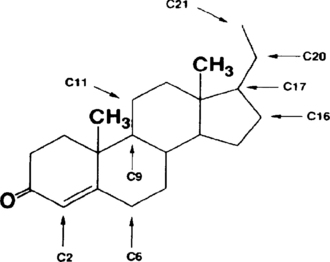Chapter 50 Topical steroids
1. When were corticosteroids discovered? When were they first used therapeutically?
• 1948: First reported use of cortisone and adrenocorticotropic hormone (ACTH) in the treatment of rheumatoid arthritis
3. How is the potency of topical steroid medications determined?
At present, the most widely used topical steroid ranking system of potency is based on the vasoconstrictor assay, where test medications are applied in serial dilutions to the forearms of the volunteers for a standard length of time. Many believe that this one measure of biologic function correlates with clinical effectiveness. Although it is difficult to compare studies because of a lack of standardization, a recent study demonstrated that therapeutic index did not correlate with the vasoconstrictor assay or clinical outcome.
4. How do topical steroids inhibit cutaneous inflammation?
The steroid molecule binds to specific cytoplasmic steroid receptors that are transported to the cell nucleus, where it interacts with high-affinity binding sites on nuclear DNA. Steroid-induced proteins, called lipocortins, are then synthesized by the target cells. There is good evidence that these proteins inhibit phospholipase A2, an enzyme necessary for formation of inflammatory mediators (e.g., arachidonic acid, prostaglandins, leukotrienes, and platelet-activating factor) that decrease vascular permeability. Another immediate effect of topical steroids is to produce vasoconstriction, thus decreasing tissue edema, erythema, and heat. The steroid molecule can also bind to cell membranes, altering their function. Inflammatory cells show reduced migration and function at sites of inflammation.
5. How are topical corticosteroids classified as to potency?
Many authors in the United States classify topical corticosteroids into seven categories of potency: 1) superpotency, 2) high potency, 3) high midpotency, 4) midpotency, 5) low midpotency, 6) mildly potent, and 7) low potency. The authors of this book prefer to rank them into four classes of potency (Table 50-1).
6. How many topical steroid medications are available in the United States?
Epocrates Rx lists over 100 brand name and generic topical products that contain corticosteroids; this does not include the various vehicles and concentrations. It is not necessary to learn all of the steroid names and preparations. Familiarity with one preparation in each potency class is often sufficient.
Table 50-1. Topical Steroid Potency*
| Group I: Super Potency (antiinflammatory activity = 500) |
| Group II: High Potency (antiinflammatory activity = 100–500) |
| Group III: Midpotency (antiinflammatory activity = 10–100) |
| Group IV: Low Potency (antiinflammatory activity = 1–10) |
OTC, Over-the-counter.
* The individual steroid molecules can be moved up or down in the potency ranking by changing the vehicle of the topical formulation.
Epocrates Rx (database for Parental Drug Association [PDA]), Version 1.0: Epocrates, Inc, San Mateo, CA. Copyright 2006 [updated Dec 14, 2009; cited Dec 14, 2009]. Available from: http://www.epocrates.com.
7. What are the differences between brand name and generic topical steroid products?
8. With so many products available, how do you decide which product to prescribe for your patient?
There are anatomic site differences in relative absorption: forearm = 1, back = 1.7, sole = 0.14, palm = 0.83, scalp = 3.5, cheek = 13, eyelid and scrotum = 42. A multitude of additional factors must be considered, including: chronicity of disease being treated, percentage of body surface involvement, patient age, specific medication, vehicle, frequency of application and technique, potential side effects, presence of coexisting factors, and cost. Importantly, if the product is unpleasing, patient compliance may be compromised.
9. What specific directions should be provided when prescribing super-, high-, and midpotency topical steroids?
Education is imperative. Side effects should be discussed, as well as correct application methods to avoid misuse. Failure to do so may result in nonadherence and irrational steroid phobia. Timely follow-up should be scheduled to monitor for treatment and side effects.




The directions should specify that the potent topical steroid should not
Stay updated, free articles. Join our Telegram channel

Full access? Get Clinical Tree









